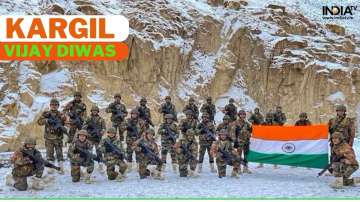Kargil Vijay Diwas 2023: Five important facts you must know about Kargil War
Kargil Vijay Diwas: Each year, 'Kargil Vijay Diwas' is celebrated on July 26 to honour the valour and sacrifice of the soldiers who gave the supreme sacrifice in the line of duty during the Kargil War in 1999.

Kargil Vijay Diwas: India is commemorating 24 years of its victory over Pakistan in the Kargil War. Each year, 'Kargil Vijay Diwas' is celebrated on July 26 to honour the valour and sacrifice of the soldiers who gave the supreme sacrifice in the line of duty during the Kargil War. On July 26, 1999, the Indian Army had announced the successful culmination of "Operation Vijay", declaring victory after a nearly three-month-long battle at the icy heights of Kargil, including super-high-altitude locations, such as Tololing and Tiger Hill. According to reports, more than 500 soldiers laid down their lives for the safety and welfare of the country.
The Kargil War was fought between May 8, 1999, and July 26, 1999, against intruders from Pakistan who had crossed the Line of Control into Indian territory during the winters of 1998. After transcending to the Indian territory, the Pakistani intruders had occupied fortified defences overlooking the NH 1A in Kargil's Drass and Batalik Sectors of Ladakh region with a nefarious aim of dominating all military and civil movement on the highway.
The Kargil War had three phases - infiltration by Pakistan so as to occupy strategic locations to bring NH1 within its control, identifying and responding to Pakistani infiltration and battles between Indian and Pakistani forces. Over a period of several months, Pakistan infiltrated into the Mushkoh Valley, the Marpo La ridgeline in Dras, in Kaksar near Kargil, in Batalik sector, in Chorbatla sector and in Siachen's Turtok sector.
Here are five important facts about the Kargil War
- The Kargil War was considered one of the most challenging wars as it was fought at high altitudes, with some posts situated at over 18,000 feet. Air power, infantry operations, and artillery were all heavily used during the war. Over 500 Indian soldiers and around 1,000 Pakistani troops lost their lives during the war.
- During the war, the Indian Air Force played an instrumental role in providing aerial support, carrying out vital airstrikes to drive the enemy out of key locations. The campaign by the Indian Armed Forces to recapture the seized Kargil heights is known as "Operation Vijay".
- The controversial Bofors FH-77B howitzers were used for the first time in the Kargil War to destroy enemies positioned at the top. The Bofors had created quite a sensation in India at that time. According to reports, as many as 2.50 lakh shells, rockets, and bombs were used during the war. In addition, around 5,000 artillery shells, rockets, and bombs were fired from 300 guns and mortars. At the time, it was said that this was the first time after World War II that such a significant amount of ammunition and bombardments had been deployed.
- It was the first ever war to be shot live and telecast on Indian television. This provided live visuals and people in the country were able to see exactly what was happening on the front lines of battle. During the war, Israel had helped India with Unmanned Aerial Vehicles (UAVs).
- A number of Indian soldiers earned awards for gallantry for showing extreme valour during the war. Four Param Vir Chakras and 11 Maha Vir Chakras were awarded. The Param Vir Chakras, the highest gallantry award, were given to Captain Vikram Batra (posthumously), Lieutenant Manoj Kumar Pandey (posthumously), Rifleman Sanjay Kumar and Grenadier Yogendra Singh Yadav.
ALSO READ: Kargil Vijay Diwas: Netizens go emotional after martyr Capt Vijayant Thapar's uniform pic surfaces